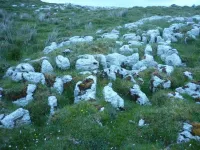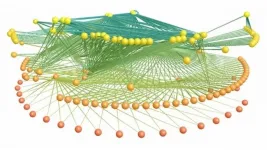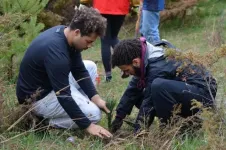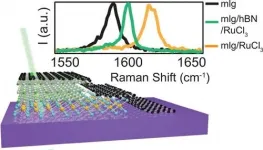INFORMATION:
Researchers show Irish soil can offer more hope in fight against antibiotic resistance
Scientists make exciting discovery in the quest to discover new antibiotics.
2021-01-14
(Press-News.org) Scientists who highlighted the bug-busting properties of bacteria in Northern Irish soil have made another exciting discovery in the quest to discover new antibiotics.
The Traditional Medicine Group, an international collaboration of scientists from Swansea University, Brazil and Northern Ireland, have discovered more antibiotic-producing species and believe they may even have identified new varieties of antibiotics with potentially life-saving consequences.
Antibiotic resistant superbugs could kill up to 1.3 million people in Europe by 2050 - the World Health Organisation (WHO) describes the problem as "one of the biggest threats to global health, food security, and development today".
The search for replacement antibiotics to combat multi-resistance has prompted researchers to explore new sources, including folk medicines focusing on environments where well-known antibiotic producers like Streptomyces can be found.
The Traditional Medicine Group discovered that soil used in ancient Irish folk medicine in the West Fermanagh scarplands contains several species of these antibiotic producing organisms. This area of caves, alkaline grassland and bog is scattered with many remnants of previous Neolithic habitation.
One of the research team, Dr Gerry Quinn, a previous resident of Boho, County Fermanagh, has been aware of the healing traditions of the area for many years. Several years ago, an analysis of the soil there led to the team discovering a previously unknown strain of bacteria effective against four of the top six hospital superbugs that are resistant to antibiotics, including MRSA.
Since then, their research has continued but given local religious sensitivities and the self-limiting nature of the original site, the group relocated their search to another area of the West Fermanagh scarplands that retained the essential alkaline nature of the grasslands whilst also providing a link to traditional folk medicine.
Dr Paul Facey, one of the lead researchers from Swansea University said: "The fact that traditional medicine is incorporated in many local folk tales led us to believe that there was a good possibility of finding strong antibiotic producing organisms in other locations in these limestone hills."
The group discovered that their latest finding was able to express an even wider range of antimicrobial activity than their previous discovery.
The results of this study have now been published in MDPI Applied Microbiology and the DNA sequence has been deposited in the American national collection.
Antibiotic tests performed by Dr Quinn, Simms Adu, from Ulster University, and Swansea University's Nada Alharbi reveal that Streptomyces sp. CJ13 inhibits the growth of multi-resistant organisms such as:
Gram negative Pseudomonas aeruginosa, a common opportunistic pathogen associated with chronic lung infections in cystic fibrosis patients;
MRSA, a common opportunistic pathogen often resistant to many antibiotics;
Anaerobic bacteria, usually found in deep wounds, which cause serious infections; and
Candida, a yeast species often overlooked in mixed bacterial infections.
The group has yet to chemically identify the compounds responsible for antibiotic activity but preliminary analysis indicates there are genetic similarities to other known antibiotic production genes.
Even though the antibiotic genes found in Streptomyces sp. CJ13 are not identical to template antimicrobials, it raises the interesting possibility that these could be new varieties of antibiotics.
Given the significant contributions made by Streptomyces to the fields of cancer and anti-viral therapies, team member Hamid Bakshi added: "We are confident in the great potential of our most recent discovery to provide many interesting discoveries."
ELSE PRESS RELEASES FROM THIS DATE:
Accounting for the gaps in ancient food webs
2021-01-14
If you want to understand an ecosystem, look at what the species within it eat. In studying food webs -- how animals and plants in a community are connected through their dietary preferences -- ecologists can piece together how energy flows through an ecosystem and how stable it is to climate change and other disturbances. Studying ancient food webs can help scientists reconstruct communities of species, many long extinct, and even use those insights to figure out how modern-day communities might change in the future. There's just one problem: only some species left enough of a trace for scientists to find eons later, leaving large gaps in the fossil record -- and researchers' ability to piece together the food webs from the past.
"When things die and get preserved as fossils, all the ...
Galaxies hit single, doubles, and triple (growing black holes)
2021-01-14
When three galaxies collide, what happens to the huge black holes at the centers of each? A new study using NASA's Chandra X-ray Observatory and several other telescopes reveals new information about how many black holes are furiously growing after these galactic smash ups.
Astronomers want to learn more about galactic collisions because the subsequent mergers are a key way that galaxies and the giant black holes in their cores grow over cosmic time.
"There have been many studies of what happens to supermassive black holes when two galaxies merge," said Adi Foord of Stanford University, who led the study. "Ours is one of the first to systematically look at what happens to ...
Physical virology shows the dynamics of virus reproduction
2021-01-14
The reproductive cycle of viruses requires self-assembly, maturation of virus particles and, after infection, the release of genetic material into a host cell. New physics-based technologies allow scientists to study the dynamics of this cycle and may eventually lead to new treatments. In his role as physical virologist, Wouter Roos, a physicist at the University of Groningen, together with two longtime colleagues, has written a review article on these new technologies, which was published in Nature Reviews Physics on 12 January.
'Physics has been used for a long time to study viruses,' says Roos. 'The laws of ...
Physical frailty syndrome: a cacophony of multisystem dysfunction
2021-01-14
In the inaugural issue of the journal Nature Aging a research team led by aging expert Linda P. Fried, MD, MPH, dean of Columbia University Mailman School of Public Health, synthesizes converging evidence that the aging-related pathophysiology underpinning the clinical presentation of phenotypic frailty (termed as "physical frailty" here) is a state of lower functioning due to severe dysregulation of the complex dynamics in our bodies that maintains health and resilience. When severity passes a threshold, the clinical syndrome and its phenotype are diagnosable. This paper summarizes the evidence meeting criteria for physical frailty as a product of complex system dysregulation. ...
Mapping our sun's backyard
2021-01-14
Astronomers have curated the most complete list of nearby brown dwarfs to date thanks to discoveries made by thousands of volunteers participating in the Backyard Worlds citizen science project. The list and 3D map of 525 brown dwarfs -- including 38 reported for the first time -- incorporate observations from a host of astronomical instruments including several NOIRLab facilities. The results confirm that the Sun's neighborhood appears surprisingly diverse relative to other parts of the Milky Way Galaxy.
Mapping out our own small pocket of the Universe is a time-honored quest within astronomy, and ...
New classification marks paradigm shift in how conservationists tackle climate change
2021-01-14
NEW YORK (January 14) -- A new study co-authored by researchers from the Wildlife Conservation Society's (WCS) Global Conservation Program and the University of British Columbia (UBC) Faculty of Forestry introduces a classification called Resistance-Resilience-Transformation (RRT) that enables the assessment of whether and to what extent a management shift toward transformative action is occurring in conservation. The team applied this classification to 104 climate adaptation projects funded by the WCS Climate Adaptation Fund over the past decade and found differential responses toward transformation ...
Behaviors surrounding oral sex may increase HPV-Related cancer risk
2021-01-14
A wide breadth of behaviors surrounding oral sex may affect the risk of oral HPV infection and of a virus-associated head and neck cancer that can be spread through this route, a new study led by researchers at the Johns Hopkins Kimmel Cancer Center suggests. These findings add nuance to the connection between oral sex and oropharyngeal cancer -- tumors that occur in the mouth and throat -- and could help inform research and public health efforts aimed at preventing this disease.
The findings were reported Jan. 11 in the journal Cancer.
In the early 1980s, researchers realized that nearly all cervical cancer is caused by the human papillomavirus (HPV), a DNA virus from the Papillomaviridae family. Although about 90% of HPV infections ...
The richer you are, the more likely you'll social distance, study finds
2021-01-14
The higher a person's income, the more likely they were to protect themselves at the early stages of the Covid-19 pandemic in the United States, Johns Hopkins University economists find.
When it comes to adopting behaviors including social distancing and mask wearing, the team detected a striking link to their financial well-being. People who made around $230,000 a year were as much as 54% more likely to increase these types of self-protective behaviors compared to people making about $13,000.
"We need to understand these differences because we can wring our hands, and we can blame and shame, but in a way it doesn't matter," said Nick Papageorge, the Broadus Mitchell Associate Professor of Economics. "Policymakers just need to recognize who is going ...
New way to control electrical charge in 2D materials: Put a flake on it
2021-01-14
Physicists at Washington University in St. Louis have discovered how to locally add electrical charge to an atomically thin graphene device by layering flakes of another thin material, alpha-RuCl3, on top of it.
A paper published in the journal Nano Letters describes the charge transfer process in detail. Gaining control of the flow of electrical current through atomically thin materials is important to potential future applications in photovoltaics or computing.
"In my field, where we study van der Waals heterostructures made by custom-stacking atomically ...
Deep learning outperforms standard machine learning in biomedical research applications
2021-01-14
ATLANTA--Compared to standard machine learning models, deep learning models are largely superior at discerning patterns and discriminative features in brain imaging, despite being more complex in their architecture, according to a new study in Nature Communications led by Georgia State University.
Advanced biomedical technologies such as structural and functional magnetic resonance imaging (MRI and fMRI) or genomic sequencing have produced an enormous volume of data about the human body. By extracting patterns from this information, scientists can glean ...
LAST 30 PRESS RELEASES:
Numbers in our sights affect how we perceive space
SIMJ announces global collaborative book project in commemoration of its 75th anniversary
Air pollution exposure and birth weight
Obstructive sleep apnea risk and mental health conditions among older adults
How talking slows eye movements behind the wheel
The Ceramic Society of Japan’s Oxoate Ceramics Research Association launches new international book project
Heart-brain connection: international study reveals the role of the vagus nerve in keeping the heart young
Researchers identify Rb1 as a predictive biomarker for a new therapeutic strategy in some breast cancers
Survey reveals ethical gaps slowing AI adoption in pediatric surgery
Stimulant ADHD medications work differently than thought
AI overestimates how smart people are, according to HSE economists
HSE researchers create genome-wide map of quadruplexes
Scientists boost cell "powerhouses" to burn more calories
Automatic label checking: The missing step in making reliable medical AI
Low daily alcohol intake linked to 50% heightened mouth cancer risk in India
American Meteorological Society announces Rick Spinrad as 2026 President-Elect
Biomass-based carbon capture spotlighted in newly released global climate webinar recording
Illuminating invisible nano pollutants: advanced bioimaging tracks the full journey of emerging nanoscale contaminants in living systems
How does age affect recovery from spinal cord injury?
Novel AI tool offers prognosis for patients with head and neck cancer
Fathers’ microplastic exposure tied to their children’s metabolic problems
Research validates laboratory model for studying high-grade serous ovarian cancer
SIR 2026 delivers transformative breakthroughs in minimally invasive medicine to improve patient care
Stem Cell Reports most downloaded papers of 2025 highlight the breadth and impact of stem cell research
Oxford-led study estimates NHS spends around 3% of its primary and secondary care budget on the health impacts of heat and cold in England
A researcher’s long quest leads to a smart composite breakthrough
Urban wild bees act as “microbial sensors” of city health.
New study finds where you live affects recovery after a hip fracture
Forecasting the impact of fully automated vehicle adoption on US road traffic injuries
Alcohol-related hospitalizations from 2016 to 2022
[Press-News.org] Researchers show Irish soil can offer more hope in fight against antibiotic resistanceScientists make exciting discovery in the quest to discover new antibiotics.




